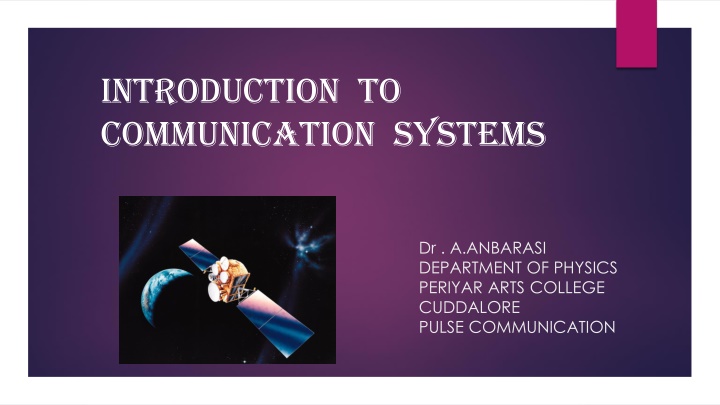
Introduction to Communication Systems and Pulse Communication
Explore the fundamentals of communication systems, including pulse communication and pulse modulation. Understand the types of modulations, communication system components, and examples of communication systems. Discover how information is transmitted through various elements in a communication system.
Download Presentation

Please find below an Image/Link to download the presentation.
The content on the website is provided AS IS for your information and personal use only. It may not be sold, licensed, or shared on other websites without obtaining consent from the author. If you encounter any issues during the download, it is possible that the publisher has removed the file from their server.
You are allowed to download the files provided on this website for personal or commercial use, subject to the condition that they are used lawfully. All files are the property of their respective owners.
The content on the website is provided AS IS for your information and personal use only. It may not be sold, licensed, or shared on other websites without obtaining consent from the author.
E N D
Presentation Transcript
INTRODUCTION TO COMMUNICATION SYSTEMS Dr . A.ANBARASI DEPARTMENT OF PHYSICS PERIYAR ARTS COLLEGE CUDDALORE PULSE COMMUNICATION
PULSE A pulse in signal processing is a rapid, transient change in the amplitude of a signal from a baseline value to a higher or lower value, followed by a rapid return to the baseline value.
PULSE MODULATION Pulse modulation is a type of modulation in which the signal is transmitted in the form of pulses. It can be used to transmit analogue information. In pulse modulation, continuous signals are sampled at regular intervals. Pulse modulation can be classified into two major types. Analogue: Indication of sample amplitude is infinitely variable Digital: Indicates sample amplitude at the nearest predetermined level.
COMMUNICATION SYSTEM Input Transducer The information in the form of sound, picture or data signals cannot the transmitted as it is. First it has to be converted into a suitable electrical signal. The input transducers commonly used in the communication systems are microphones, TV etc.
Examples of communication systems The following are a few examples of communication systems: 1. Internet 2. Public Switched Telephone network 3. Intranet and Extranet 4. Television
Elements of communication systems 1. Information 2.Signal 3.Transducer 4.Amplifier 5.Modulator
1.INFORMATION Message or information is the entity that is to be transmitted. It can be in the form of audio, video, temperature, picture, pressure, etc.
2.SIGNAL The single-valued function of time that carries the information. The information is converted into an electrical form for transmission.
3. TRANSDUCER A device or an arrangement that converts one form of energy to the other. An electrical transducer converts physical variables such as pressure, force, temperature into corresponding electrical signal variations. Example: Microphone converts audio signals into electrical signals. Photodetector converts light signals into electrical signals.
4. AMPLIFIER The electronic circuit or device that increases the amplitude or the strength of the transmitted signal is called an amplifier. When the signal strength becomes less than the required value, amplification can be done anywhere in between transmitter and receiver. A DC power source will provide for the amplification.
5.MODULATOR As the original message signal cannot be transmitted over a large distance because of their low frequency and amplitude, they are superimposed with high frequency and amplitude wave called carrier wave. This phenomenon of superimposing of message signal with a carrier wave is called modulation. And the resultant wave is a modulated wave which is to be transmitted.
Different types of modulation i ) Amplitude Modulation (AM) ii ) Frequency Modulation (FM) iii ) Phase Modulation (PM)
1.AMPLITUDE MODULATION (AM) The process of changing the amplitude of the signal wave by impressing or superimposing it on a high-frequency carrier wave, keeping its frequency constant is called amplitude modulation.
2.FREQUENCY MODULATION (FM) Frequency modulation is a technique in which the frequency of the message signal is varied by modulating with a carrier wave. It is better than deficient than amplitude modulation because it eliminates noise from various sources.
3. Phase modulation (PM) The phase of the carrier wave changes the phase of the signal wave. The phase shift after modulation is dependent on the frequency of the carrier wave as well. Phase modulated waves are immune to noise to a greater extent.
TRANSMITTER & ANTENNA Transmitter It is the arrangement that processes the message signal into a suitable form for transmission and subsequently reception. Antenna An Antenna is a structure or a device that is radiate and receive electromagnetic waves. So, they are used in both transmitters and receivers. An antenna is basically a metallic object, often a collection of wires. The electromagnetic waves are polarised according to the position of the antenna
ATTENUATION Attenuation is a problem caused by the medium. When the signal is propagating for a longer distance through a medium, depending on the length of the medium the initial power decreases. The loss in initial power is directly proportional to the length of the medium. Using amplifiers, the signal power is strengthened or amplified so as to reduce attenuation. Also, digital signals are comparatively less prone to attenuation than analogue signals.
DEMODULATION Demodulation is extracting the original information-bearing signal from a carrier wave. A demodulator is an electronic circuit (or computer program in a software- defined radio) that is used to recover the information content from the modulated carrier wave.
TYPES OF COMMUNICATION SYSTEM Depending on Signal specification or technology, the communication system is classified as follows: (1) Analog Analog technology communicates data as electronic signals of varying frequency or amplitude. Broadcast and telephone transmission are common examples of Analog technology. (2) Digital In digital technology, the data are generated and processed in two states: High (represented as 1) and Low (represented as 0). Digital technology stores and transmits data in the form of 1s and 0s.
RECEIVER An arrangement that extracts the message or information from the transmitted signal at the output end of the channel and reproduces it in a suitable form as the original message signal is a receiver.
DEMODULATOR It is the inverse phenomenon of modulation. The process of separation of message signal from the carrier wave takes place in the demodulator. The information is retrieved from the modulated wave.
THE COMMUNICATION PROCESS the most fundamental sense, communication involves the transmission of information from one point to another through a succession of process as listed below : The generation of a thought pattern or image in the mind of an originator. The description of that image, with a certain measure of precision, by a set of oral visual symbols. The encoding of these symbols in a form that is suitable for transmission over a physical medium of interest. The transmission of the encoded symbols to the desired destination. The decoding and reproduction of the original symbols. The recreation of the original thought pattern or image, with a definable degradation in quality, in the mind of recipient. 1. 2. 3. 4. 5. 6.






















